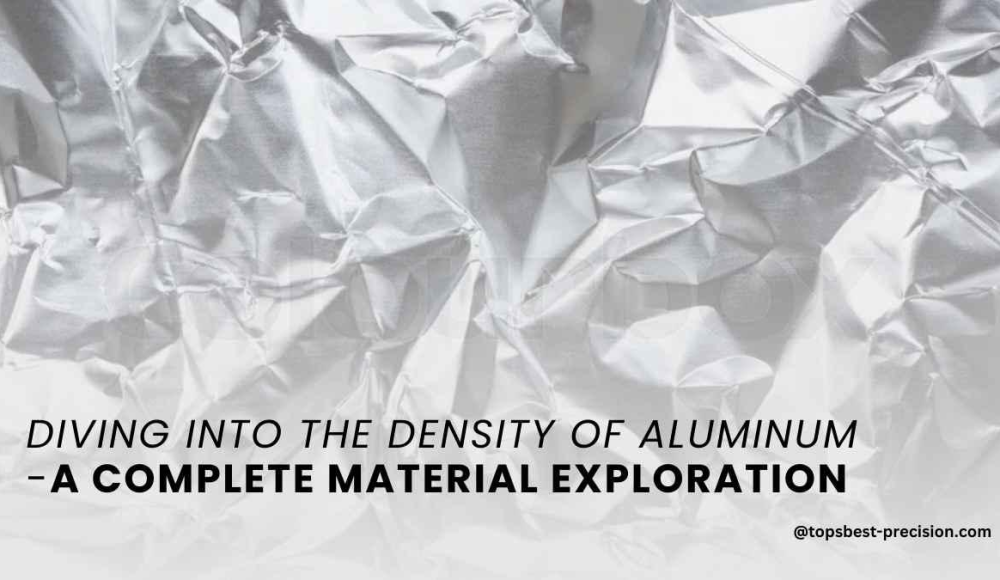なぜアルミニウムがこれほど多くの産業で使用されているのか, 航空宇宙や包装など? 秘密はその濃さ, それらを軽くし、通常有用にする要因. しかし, アルミニウム密度のこの特性がパフォーマンスにどのように影響するかを判断することは困難になります. 軽量構造を選択している場合でも、特定の製品に適した素材を選択している場合でも, アルミニウムの密度が成功の鍵かもしれません. ここで、このプロパティがすべての業界で不可欠である理由と、その材料の機能への影響について説明しましょう.
なぜアルミニウム密度が重要なのか?
アルミニウムの密度は、異なる用途での材料の性質と相互作用を決定します. どちらか一方でその強さと重量を定義します. したがって, その密度の知識は重要です アルミニウム 航空宇宙で決定を下すための資料として, 自動車, および包装産業, 軽量でありながら強力な素材が評価されている場合.
アルミニウムの密度
アルミニウムの密度は比較的低いです 2.7 g/cm3 他の多くの金属と比較して. アルミニウムの低密度とその強度は、軽量の製造に価値があります, まだ強力な製品. それで, 航空宇宙のような業界で広く使用されています, 自動車, と包装.
アルミニウムの密度に影響する要因
いくつかの要因がアルミニウムの密度とその特性に影響します, 多数のアプリケーションでのパフォーマンス, および処理技術. アルミニウムの密度に影響を与える重要な技術的要因は次のとおりです:
温度
ほとんどの金属, およびアルミニウム, 特に, 加熱すると拡張します. 温度が上昇すると、アルミニウムの原子が振動するためにより多くのエネルギーを獲得します. したがって、原子は引き離されます. 膨張により密度が低下します. 例えば, RTでの固体アルミニウムの電子構成 (20 ℃) に等しい 2.70 g/cm³一方、高温で拡張されたアルミニウムのそれ, のような 473 K, に等しい 2.63 g/cm3.
合金組成
純粋なアルミニウムには密度があります 2.70 g/cm³ですが、アルミニウム含有量の割合が高くなっています, 密度はからです 2.6 に 2.8 銅などの金属を備えたg/cm³, マグネシウム, シリコン, または合金に影響する亜鉛. 例えば, アルミニウムおよび銅合金の, 後者はより高い密度を示します 2.80 G/cm³銅原子はアルミニウムよりも原子量が高いため.
プレッシャー
ダイヤモンドの密度がわずかに上昇するほど高圧でなくても、アルミニウムが高圧下に置かれている場合. 材料が高圧で圧縮されるため. しかし, 一般的に, 製造条件, そして、圧力はアルミニウムの密度に大きな影響を与えません. 深い圧力や航空宇宙圧力などのこのような特定の用途で, 圧力は材料の特性に大きな影響を与える可能性がありますが、圧力は通常の圧力下でのバルク密度に最小限の影響を与えます.
気孔率と微細構造
アルミニウム密度と粒界のサイズ分布は、アルミニウムの有効密度に影響を与える可能性のある微細構造的特徴です. 内部多孔性がポケットやボイドを放送する可能性があるため、より多くの内部多孔性を持つアルミニウムは明らかな密度が低くなります. 鍛造アルミニウム中の細かく均一な穀物は、内部多孔性を最小限に抑えることにより、密度がわずかに増加する可能性があります.
不純物
アルミニウムの合金要素, 酸素を含む, 水素, または他の要素, 密度に影響します. 例えば, 金属に浸透する水素 (通常、鋳造中に吸収された水から) ボイドの形成を引き起こす可能性があります, その結果、その密度が変化します. 不純物はまた、合金の一般的な組成を変え、密度とともに原子の配置に影響を与えます.
硬化とひずみを働かせます
たとえばローリングのための使用プロセスで, 鍛造, または、押出アルミニウムを作業硬化にさらすことができます. このプロセスは、結晶構造に転位を導入することにより、金属の強度を高めます. 株の形成による原子パッキングの増加のために、作業中のアルミニウムの密度はわずかに高くなる可能性があります.
重要な特性による金属の比較
以下は、密度に基づいたアルミニウムと他の一般的な金属との比較です, 原子番号, 融点, 沸点, 原子半径, および結晶構造:
| 金属 | 密度 (g/cm3) | 原子番号 | 融点 (℃) | 沸点 (℃) | 原子半径 (午後) | 結晶構造 |
| アルミニウム | 2.70 | 13 | 660 | 2,470 | 143 | 顔中心の立方体 (FCC) |
| 銅 | 8.96 | 29 | 1,085 | 2,562 | 128 | 顔中心の立方体 (FCC) |
| 鋼鉄 (炭素) | 7.85 | 不定 (fe = 26) | 1,370 | 2,500 | 126 | 体中心の立方体 (BCC) または顔中心の立方体 (FCC) タイプに応じて |
| 鉛 | 11.34 | 82 | 327 | 1,750 | 175 | 顔中心の立方体 (FCC) |
| 金 | 19.32 | 79 | 1,064 | 2,856 | 144 | 顔中心の立方体 (FCC) |
| チタン | 4.43 | 22 | 1,668 | 3,287 | 147 | 六角形の密集 (医療従事者) |
| ニッケル | 8.90 | 28 | 1,455 | 2,913 | 124 | 顔中心の立方体 (FCC) |
| 亜鉛 | 7.14 | 30 | 419 | 907 | 139 | 六角形の密集 (医療従事者) |
| 鉄 | 7.87 | 26 | 1,538 | 2,862 | 126 | 体中心の立方体 (BCC) |
| マグネシウム | 1.74 | 12 | 650 | 1,090 | 160 | 六角形の密集 (医療従事者) |
アルミニウムグレード間の密度の変動
これは、さまざまなアルミニウムグレードの密度と重要な特性の比較です:
| プロパティ/条件 | 1100 シリーズ | 2024 学年 | 3003 学年 | 5052 学年 | 6061 学年 | 7075 学年 |
| 密度 (g/cm3) | 2.71 | 2.78 | 2.73 | 2.68 | 2.70 | 2.81 |
| 強さ | 低い | 高い | 適度 | 高い | 高い | 非常に高い |
| 耐食性 | 素晴らしい | 適度 | 良い | 素晴らしい | 良い | 適度 |
| 典型的な使用 | 食べ物 & 化学産業 | 航空機, 航空宇宙 | 屋根付き, 調理器具 | マリン, 圧力容器 | 構造的, 航空宇宙 | 航空宇宙, 軍隊 |
| 成形性 | 素晴らしい | 適度 | 良い | 良い | 良い | 適度 |
| 溶接性 | 素晴らしい | 公平 | 良い | 良い | 良い | 公平 |
一般的なアルミニウム合金とその組成
これは、いくつかのアルミニウム合金とその組成と密度のリストです.
| 合金シリーズ | 合金タイプ | 構成 (主要な要素) | 密度 (g/cm3) | 一般的な用途 |
| 1000 シリーズ | 1100 | 99%+ アルミニウム | 2.71 | 食品化学産業, 装飾, および熱交換器 |
| 2000 シリーズ | 2024 | アルミニウム, 銅 (3.8–4.9%), マンガン, マグネシウム | 2.78 | 航空宇宙, 軍隊 (高強度, しかし、腐食抵抗が不十分です) |
| 3000 シリーズ | 3003 | アルミニウム, マンガン (1.0–1.5%), 銅 | 2.73 | 屋根付き, 調理器具, 圧力容器 |
| 4000 シリーズ | 4032 | アルミニウム, ケイ素 (12–13%), 銅, 鉄 | 2.70 | 自動車, 高性能エンジン部品 |
| 5000 シリーズ | 5052 | アルミニウム, マグネシウム (2.5–3.5%), クロム | 2.68 | 海洋環境, 圧力容器, 燃料タンク |
| 6000 シリーズ | 6061 | アルミニウム, マグネシウム (0.8–1.2%), ケイ素 (0.4–0.8%) | 2.70 | 構造用途, 航空宇宙, 自動車, 工事 |
| 7000 シリーズ | 7075 | アルミニウム, 亜鉛 (5.1–6.1%), マグネシウム (2.1–2.9%), 銅 | 2.81 | 航空宇宙, 軍隊, スポーツ用品 (高強度) |
| 8000 シリーズ | 8006 | アルミニウム, 鉄, ケイ素 | 2.72 | 包装, アルミホイル, 家庭用品 |
密度計算とアルミニウムの実生活用途
そのアプリケーションを含むアルミニウムの密度を決定する際の手順について説明しましょう.
アルミニウムの密度計算
密度の式はです:
密度(r)=質量/ボリューム
どこ:
- 密度はg/cm³またはkg/m³で測定されます.
- 質量はオブジェクトの重みです (グラムまたはキログラムで).
- ボリュームは、オブジェクトが占めるスペースです (cm³またはm³で).
例えば, アルミニウムブロックの密度を計算しましょう. 次の測定でアルミニウムブロックがあるとします:
- 質量= 1350 グラム
- ボリューム= 500 cm3
の典型的な密度 純粋なアルミニウムがあります 2.70 g/cm3. アルミニウムの合金バージョン用, 密度は、追加された特定の要素によってわずかに異なる場合があります, 銅のように, マグネシウム, または亜鉛.
実際の用途におけるアルミニウムの密度
アルミニウムの密度は、実用的な生活におけるその応用にも重要な役割を果たしています. アルミニウムの密度が重要な特定の産業があります:
航空宇宙と航空
アルミニウムは、密度が低いため、航空機と航空宇宙部品の製造に使用することをお勧めします. アルミニウム合金の主な利点, 具体的には低密度, 飛行機とロケットを建設するための燃料要件が少ない, より大きなペイロード, しかし、ほぼ等しい強さ. などの多くの構造アプリケーション 2024 そして 7075 強度と低密度が重要な場合に合金が使用されます.
自動車産業
自動車業界で, アルミニウムの密度は、燃料効率の向上に役立ちます. 軽い材料は、車両の移動に使用されるエネルギーが少ないことに変換されます. したがって、, より少ない排出とより良いパフォーマンスを得ることができます. しかし, エンジンブロックの製造に広く使用されています, および送信, 車の体と同様に.
包装
密度が比較的低いおかげです, アルミニウムは包装産業で大いに使用されています. アルミホイルと飲料缶の生産に最も頻繁に使用されます. 密度が低いため、製品をより軽量で梱包できるため、輸送コストが削減されますが、パッケージは内容を保護するのに十分な強度と頑丈さを提供します。. さらに, これにより、必ずしも強度を高めるために厚い素材を使用する必要なく、パッケージングで使用するのに適した薄いシートに変換できます.
工事
アルミニウムは建設活動に広く適用されており、建物と構造を作成します, 窓やドアなど, 屋根, メンバーの橋渡し. 密度が低いため、これらのコンポーネントは強くて軽くなります, 意味の少ない荷物が構造基盤に配置されますが、パネルを屋外または沿岸環境で使用する場合、耐久性と耐食性が必要です。.
スポーツ用品
自転車で, 野球のバット, ゴルフクラブ, と釣り竿, 密度が低いアルミニウム合金は、その重量に対して強くなります. 加えて, この密度により、メーカーは最高のパフォーマンスを提供するのに十分な強度の機器を設計できますが、アスリートが使用するのに十分なポータブルであることができます.
重要なポイント
結論としては, アルミニウムの密度は、この金属がさまざまな役割でどのように機能するかについて多くのことを明らかにしています. その密度はアルミニウムを貴重にします. 強さと軽量が重要な産業に適しています. これらには航空宇宙が含まれます, 自動車, そして建設. 強度を失うことなく体重を減らすことができるという事実は、より良い走行距離をもたらします, パワーの増加, そして費用が少ない.
さらに, 腐食能力とさまざまな形や形状に成形する能力は、包装材料やスポーツ用品などの日常製品の適応性を高めます. アルミニウムの密度を知り、その知識を適用します, 業界には、さらなる利用に最適なソリューションが提供されています, したがって、材料の利点に焦点を当てています, この製品を利用するセクターの効率性と同様に. お問い合わせ 詳細については.



